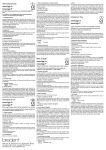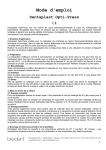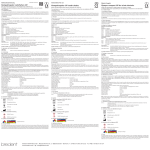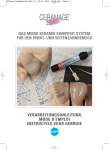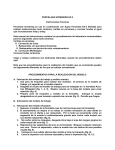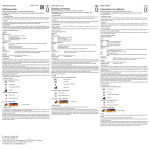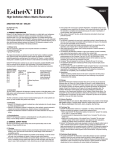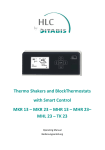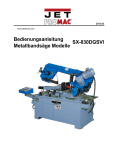Download neo.lign A, neo.lign P neo.lign A, neo.lign P neo.lign A
Transcript
Gebrauchsanweisung D neo.lign A, neo.lign P Bitte diese Gebrauchsanweisung vor dem Produkteinsatz ausführlich lesen. Für Schäden, die durch Nichtbeachtung dieser Gebrauchsanweisung entstehen, lehnt der Hersteller jede Haftung ab. 1. Einsatzbereich neo.lign A (Anterior) und neo.lign P (Posterior) sind künstliche Zähne aus Kunststoff zur Herstellung von Dentalprothesen im zahntechnischen Labor. Die neo.lign Vollzähne sind form- und farbgleich zu den novo.lign Verblendschalen und eignen sich besonders für die Herstellung kombinierten Zahnersatzes, Implantatgetragenen Prothesen sowie für die Kronen- und Brückentechnik. Durch die individuell vorgefertigte Zahnform ist eine schnelle Herstellung von Prothesen und Verblendungen möglich. Auch eine persönliche Individualisierung ist möglich. 2. Verarbeitung Aus dem Sortiment verschiedener Farben und Formen werden zunächst unter Berücksichtigung der physiognomischen Patientensituation oder einer ästhetischen Planung die zu ersetzenden bzw. zu verblendenden Zähne ausgesucht. Dabei erfolgt die Auswahl der Farbe mittels eines Farbschlüssels, z.B. klassische A-D Farben nach Vita. Für Auswahl der Form und Zahngröße steht eine Formenkarte zur Verfügung. Die Informationen über Farbe und Form (Design) sind auf der Zahnleiste aufgedruckt. Durch Beschleifen (mittels Hartmetallfräser) erfolgt die Anpassung der Konfektionszähne auf die konkrete Patientensituation. Die Zähne werden auf eine Wachsbasis aufgestellt, mittels Ästhetikanprobe können Zahnfarbe, Zahnform und Zahnstellung sowie wichtige ästhetische und funktionelle Aspekte mit dem Zahnarzt und Patienten abgestimmt werden. Die Wachsaufstellung wird je nach verwendetem System z.B. in Gips eingebettet, danach das Wachs durch Ausbrühen entfernt. neo.lign A und neo.lign P Vollzähne verbinden sich mit Prothesenbasiswerkstoffen auf heiß- oder kalthärtenden Polymethylmethacrylaten (PMMA-Basis) sowie thermoplastischen Prothesenbasiswerkstoffen auf PMMA-Basis durch chemischen Verbund. Dazu werden die basalen Flächen der Zähne angeraut, z.B. mit einem Hartmetallfräser oder aus der Küvette entfernt und mittels 110 µm Aluminiumoxyd aus dem Einmalstrahler mit 2-3 bar Druck angestrahlt. Auf die angestrahlten bzw. angerauten Flächen kann durch Auftrag eines Haftvermittlers z.B. Haftconnector bredent REF 520 0029 2 die Verbundfestigkeiten gesteigert werden. Die Verwendung eines Haftvermittlers ist aber nicht erforderlich, sofern die Gebrauchsanweisung des jeweiligen Prothesenbasiswerkstoffes eine Verwendung nicht vorschreibt. Danach erfolgt die Pressung bzw. Injection des Prothesenbasis-Kunststoffes nach Gebrauchsanweisung. Anschließend kann mittels crea.lign eine Individualisierung der Zähne als auch der Prothesenbasis erfolgen, bitte Gebrauchsanweisung crea.lign befolgen. Nach dem Ausarbeiten erfolgt das Polieren der gesamten Prothese inkl. der Zähne. 3. Nebenwirkungen und Risiken Beim Beschleifen der Zähne kann es durch Austreten von PMMA vereinzelt zu allergischen Reaktionen kommen. Sollte es zu anderen Nebenwirkungen und Risiken kommen, informieren Sie bredent umgehend. 4. Reinigung von Prothesen Zur Reinigung von Prothesen keine reaktiven Prothesenreinigungsmittel verwenden. Mit handelsüblichen Zahnpasten und Prothesenreinigungsbürsten reinigen. 5. Verwendete Symbole Chargenbezeichnung 6. Sonstige Hinweise Die Angaben dieser Gebrauchsanweisung werden stets den aktuellsten Ergebnissen und Erfahrungen angepasst. Wir empfehlen daher, vor Benutzung einer neuen Packung, die Gebrauchsanweisung zu lesen. Diese unverbindlichen Anwenderempfehlungen beruhen auf eigenen Erfahrungen. Der Benutzer ist für die Anwendung des Produktes selbst verantwortlich. Für fehlerhafte Ergebnisse wird nicht gehaftet, da bredent keinen Einfluss auf die Weiterverarbeitung hat. Eventuell dennoch auftretende Schadenersatzansprüche beziehen sich ausschließlich auf den Warenwert unserer Produkte. Instructions for use GB neo.lign A, neo.lign P Before using the product, please read these instructions for use carefully. The manufacturer will not accept any liability for damage resulting from non-compliance with these instructions for use. 1. Indication range neo.lign A (Anterior) und neo.lign P (Posterior) are artificial teeth made of acrylic material for the fabrication of dental restorations in the dental laboratory. The shapes (designs) and shades of the neo.lign denture teeth are identical with those of the novo.lign veneers and are particularly suited for the fabrication of combined restorations, implant-supported dentures and for crown and bridgework. The individual, prefabricated tooth design allows for fast fabrication of dentures and veneers and even enables customization. 2. Processing The teeth to be replaced or to be veneered are selected from the range of various shades and design whilst taking the physiognomic characteristics of the patient or esthetic planning into account. The shade is selected with a shade guide, such as the classical A-D shades according to VITA. A design chart is available for selecting the design and the tooth size. The information on the shade and the design is printed on the tooth bar. GmbH & Co. KG · Weissenhorner Str. 2 · 89250 Senden · Germany Tel. (+49) 0 73 09 / 8 72-22 · Fax (+49) 0 73 09 / 8 72-24 www.bredent.com · e-mail [email protected] The prefabricated teeth are adapted to the specific patient situation by milling (using tungsten carbide burs). The teeth are set up in a wax base; based on the esthetic try-in, dentist and patient can decide on major aspects of esthetics and function and the tooth shade, tooth design and set-up of the teeth. Depending on the systems in use, the wax set-up is invested in plaster (for example) and the wax is boiled out. neo.lign A and neo.lign P denture teeth form a chemical bond and bond to denture base materials based on heat- or cold-curing polymethyl methacrylates (PMMA-based) and thermoplastic, PMMA-based denture base materials. To achieve perfect bonding, the basal surfaces of the teeth are roughened, for example using a tungsten carbide bur, or removed from the flask and sandblasted with 110 µm aluminium oxide at a pressure of 2-3 bars. The bond strength can be increased by applying a bonding agent, for example Haftconnector bredent REF 520 0029 2, to the sandblasted or roughened surfaces. The use of a bonding agent, however, is not required unless the use is prescribed in the instructions for use of the respective denture base material. Then the denture base resin is pressed or injected in accordance with the instructions for use. Subsequently, crea.lign can be used both for customizing the teeth and the denture base; please observe the information in the instructions for use. After finishing, the complete denture including the teeth is polished. 3. Side effects and risks Limited cases of allergic reactions may result from grinding the teeth owing to the release of PMMA. Please notify bredent immediately, if other side effects and risks occur. 4. Cleaning of dentures Do not use reactive denture cleaning agents for cleaning dentures. Use standard tooth pastes and denture cleaning brushes for cleaning. 5. Symbols Lot number 6. Additional information The information contained in these instructions for use is always updated according to the latest knowledge and experience. Therefore we recommend to read the instructions for use again before using a new package. These non-binding user recommendations are based on our own experience. The user himself is responsible for processing the product. Liability for incorrect results shall be excluded since bredent does not have any influence on further processing. Any occurring claims for damages may only be made up to the value of our products. Mode d’emploi neo.lign A, neo.lign P F Veuillez lire attentivement ce mode d’emploi avant d’utiliser le produit. Le fabricant décline toute responsabilité pour tout dommage qui résulterait de la non observation de ce mode d’emploi. 1. Domaine d’application neo.lign A (Anterior) et neo.lign P (Posterior) sont des dents artificielles en résine pour la réalisation de prothèses dentaires au laboratoire de prothèse dentaire. Les dents complètes neo.lign présentent des formes et teintes identiques aux facettes novo.lign et elles sont particulièrement bien adaptées pour la réalisation de prothèses combinées, de prothèses implanto-portées ainsi que pour les techniques des couronnes et des bridges. En raison de la forme personnalisée de ces dents, il est possible de réaliser rapidement des prothèses et revêtements céramiques. Une personnalisation tout à fait individuelle est également possible. 2. Mise en œuvre Dans la gamme des différentes teintes et formes, on sélectionne d’abord les dents à remplacer ou les facettes à appliquer sur les dents restantes en tenant compte de la physionomie du patient ou d’une planification esthétique. La sélection des teintes se fait sur la base d’un nuancier, par ex. les teintes classiques A-D selon Vita. Pour le choix de la forme et de la taille des dents, une carte des formes est disponible. Les informations sur la teinte et la forme (design) sont imprimées sur la bordure de la dent. Par meulage (fraise en carbure de tungstène) on réalise l’adaptation des dents artificielles à la situation concrète chez le patient. Les dents sont alors montées sur une base en cire ; l’essai esthétique en bouche permet d’accorder la teinte des dents, leur forme et leur position par le chirurgien-dentiste et son patient. Selon le système utilisé, le montage de cire sera mis en revêtement par ex. dans du plâtre, ensuite la cire sera enlevée par ébouillantage. Les dents complètes neo.lign A und neo.lign P forment une cohésion chimique avec les matériaux pour bases de prothèses réalisées à base de méthacrylates de polyméthyle (à base de PMMA) polymérisant à chaud ou à froid ainsi que de matériaux pour bases de prothèses thermoplastiques à base de PMMA. A cet effet, on confère de la rugosité aux surfaces basales des dents, en utilisant par ex. une fraise en carbure de tungstène ou bien en les enlevant de la cuvette et en les sablant avec de l’oxyde d’aluminium émanant d’une sableuse à emploi unique sous une pression de 2-3 bars. En appliquant un adhésif sur les surfaces sablées ou rendues rugueuses, par ex. le connecteur de cohésion bredent REF 520 0029 2, on peut augmenter la force de cohésion. L’utilisation d’un adhésif n’est toutefois pas nécessaire dans la mesure où ceci n’est pas prescrit dans le mode d’emploi du matériau pour bases de prothèses respectifs. Ensuite on procède – selon le mode d’emploi – à la pressée ou injection de la résine pour base de prothèse. Par la suite, on peut réaliser une personnalisation des dents tout comme de la base de la prothèse en se servant de crea.lign ; veuillez observer le mode d’emploi de crea.lign; après la prise, on procède au polissage de la prothèse complète, à l’inclusion des dents. 3. Effets secondaires et risques Lors du meulage des dents, il peut y avoir dans de rares cas des réactions allergènes en raison de dégagements de PMMA. S’il devait y avoir d’autres effets secondaires et risques, nous vous prions d’en informer tout de suite bredent. 4. Nettoyage des prothèses Pour le nettoyage des prothèses, ne pas utiliser de produits de nettoyage réactifs. Nettoyer avec les dentifrices et brosses de nettoyage de prothèse d’usage dans le commerce. 5. Symboles utilisés Désignation de la charge 6. Divers Les recommandations de mise en œuvre de ce mode d’emploi sont basées sur les connaissances techniques et expériences actuelles. C’est pourquoi nous recommandons de lire le mode d’emploi avant l’utilisation d’une nouvelle boîte. Ces recommandations destinées à l’utilisateur sont basées sur nos propres expériences. L’utilisateur est lui-même responsable de l’utilisation du produit. N’ayant aucune influence sur sa mise en œuvre, le fabricant ne saurait être tenu responsable de résultats défectueux ou non satisfaisants. Toute indemnisation éventuelle se limitera à la valeur du produit. Istruzioni d‘uso neo.lign A, neo.lign P I Leggere attentamente le istruzioni per l’uso prima dell’utilizzo del prodotto. Per eventuali danni, verificatisi a causa di non aver rispettato la presente istruzione, il produttore non si assume nessuna responsabilità. 1. Campo d’impiego neo.lign A (per elementi frontali) e neo.lign P (per elementi diatorici) sono denti preconfezionati in resina per la realizzazione di protesi dentali nel laboratorio odontotecnico. Gli elementi pieni neo.lign hanno la stessa forma e colore delle faccette estetiche novo.lign e sono particolarmente indicati per la realizzazione di lavori combinati, protesi a supporto implantare e per ponti e corone. Grazie alla forma preconfezionata individualmente è possibile realizzare in modo veloce protesi e rivestimenti. E’ possibile anche una caratterizzazione individuale. 2. Lavorazione Inizialmente si scelgono dal set gli elementi per la sostituzione od il rivestimento, in base alle diverse forme e colori, tenendo conto della situazione del paziente dal punto di vista fisiognomico o della pianificazione estetica. La scelta del colore avviene con l’ausilio di una scala colori, p.es.con la scala colori classica Vita A-D. Per la scelta della forma e della grandezza del dente è disponibile una cartella delle forme. Le informazioni su forme (Design) e colori sono impresse sulle file degli elementi. Con la rifinitura (per mezzo di una fresa in carburo di tungsteno) si adatta il dente preconfezionato alla situazione reale del paziente. I denti vengono montati su una base in cera, e grazie alla prova estetica è possibile verificare insieme all’odontoiatra ed al paziente, il colore, la forma e la posizione così come gli importanti aspetti estetici e funzionali. La modellazione in cera viene rivestita in base al sistema utilizzato, p.es in gesso, e successivamente rimossa, sciogliendola con acqua bollente. Gli elementi pieni neo.lign A e neo.lign P si fissano per adesione chimica ai materiali per basi protesiche in polimetilmetacrilati a caldo ed a freddo (basi in PMMA) ed a materiali termoplastici per basi protesiche a base di resine acriliche PMMA. Si procede quindi ad irruvidire le superfici alla base dei denti, p.es. con una fresa in carburo di tungsteno od appena estratte dalla muffola, sabbiandole con 110 µm di ossido di alluminio a 2-3 bar di pressione con una sabbiatrice monofasica. Sulle superfici sabbiate ed irruvidite è possibile accrescere il potere d’adesione, applicando un adesivo, p.es. Haftconnector della bredent (REF 520 0029 2). Non è necessario utilizzare un adesivo, qualora le istruzioni d’uso dei materiali per basi protesiche utilizzati, non lo prescrivano. Successivamente si procede alla zeppatura ed alla fase d’iniezione della resina per basi protesiche, conformemente alle relative istruzioni d’uso. Al termine è possibile caratterizzare i denti o le basi protesiche con crea.lign, seguendo le istruzioni d’uso di crea.lign. Dopo la rifinitura si esegue la lucidatura dell’intera protesi, inclusi i denti. 3. Effetti collaterali e rischi Durante la rifinitura dei denti, a causa della formazione di polveri PMMA possono verificarsi reazioni allergiche. Nel caso dovessero insorgere altri effetti collaterali e rischi, Vi preghiamo di informare immediatamente la bredent. 4. Pulizia delle protesi Per la pulizia delle protesi non utilizzare detergenti reattivi per protesi. Pulire con dentifrici e spazzolini per protesi in commercio. 5. Simboli utilizzati Numero della partita 6. Ulteriori avvertenze I consigli e le avvertenze contenute in queste istruzioni d’uso sono aggiornati di continuo alle nuove conoscenze ed esperienze. Vi consigliamo quindi di leggere nuovamente le istruzioni d’uso del prodotto prima di utilizzare una nuova confezione. Questi consigli all’utente non sono vincolanti e si basano sulle esperienze aziendali. L’utente è personalmente responsabile dell’utilizzo del prodotto. La bredent non si assume alcuna responsabilità per risultati non conformi, poiché non hanno alcuna influenza sulle lavorazioni successive. Nel caso in cui, tuttavia, fosse richiesto un risarcimento dei danni, questo sarà commisurato esclusivamente al valore commerciale dei nostri prodotti. Hoja de instrucciones neo.lign A, neo.lign P E Rogamos lean antes de usar el producto las hojas de información sobre el producto. Por daños producidos por no tener en cuenta esta hoja de instrucción, el fabricante no se hace responsable. 1. Campo de uso neo.lign A (Anterior) y neo.lign P (Posterior) son dientes artificiales de resina para la creación de protesis dentales en el laboratorio dental. Los dientes completos neo.lign son iguales en su forma y color a las carrillas novo.lign y esta indicado sobre todo para la creación de trabajos combinados, protesis implanto-, así como en la técnica de coronas y puentes. Por la forma ya creada del diente se puede realizar una protesis y revestidos en poco tiempo. Es posible también una individualización personalizada. 2. Modo de empleo Del surtido se elegirá de los diferentes colores y formas teniendo en cuenta la fisonomía del paciente o la planificación estética los dientes correspondientes. El color se elegirá a través de una guía de colores, como por ejemplo los colores clásicos A-D según Vita. Para la elección de la forma y tamaño de los dientes se realizará a través de una carta de formas. La información sobre los colores y formas (Diseño) se ha impreso en el zócalo del diente. Por medio del repasado (con una fresa de tungsteno) se conseguirá el ajuste de los dientes confeccionados a la situación del paciente. Los dientes se montarán sobre una base de cera, pudiendo realizar una prueba estética, control de color y posición de dientes, así como concretar importantes aspectos funcionales y estéticos con el odontólogo y paciente. El montaje en cera se enmuflará según los diferentes sistemas existentes, como por ejemplo en escayola, retirando posteriormente la cera con agua caliente. neo.lign A y neo.lign P tienen una unión con la resina para protesis sea termo- o autopolimerizable (base PMMA), así como material para prótesis termoplásticos a base de PMMA por medio de una unión química. Para ello se dejarán los talones de los dientes rugosos, como por ejemplo con una fresa de tungsteno o se retira de la mufla y se arena con óxido de aluminio de 110 µm a 2-3 bares de presión. Sobre la superficie arenada o rugosa se podrá pincelar un adhesivo (Conector) de bredent REF 520 0029 2, que aumenta la adhesión. La utilización de un adhesivo no es necesaria, siempre y cuando el fabricante de la resina de prótesis no lo indique. Después se realizará el prensado o inyección de la resina para prótesis según ala hoja de instrucción. Posteriormente se podrá individualizar por medio de crea.lign los dientes, así como también la resina, seguir los pasos que se indica en la hoja de instrucciones del crea.lign. Una vez se ha repasado, se continuará con el pulimento de la completa inclusive los dientes 3. Efectos secundarios y riesgos Durante el repasado de los dientes puede salir PMMA y producir una reacción alérgica. Si hubiesen otros efectos secundarias y riesgos, rogamos informen a la casa bredent. 4. Limpieza de la prótesis Para la limpieza de la prótesis no utilizar productos de limpieza reactivos. Utilizar las pastas de dientes y cepillos para limpieza de protesis habituales. 5. Símbolos utilizados Designación del lote GmbH & Co. KG · Weissenhorner Str. 2 · 89250 Senden · Germany Tel. (+49) 0 73 09 / 8 72-22 · Fax (+49) 0 73 09 / 8 72-24 www.bredent.com · e-mail [email protected] 009355 EX-20090701 6. Consejos adicionales La información sobre el producto se acoge a los últimos resultados y experiencias sobre el mismo. Por ello aconsejamos antes de su uso leer de nuevo la información sobre el producto. Todos los consejos con respecto a su manipulación se basan en nuestra propia experiencia y solo se podrá ver como información orientativa. Nuestros productos están constantemente a desarrollo. Nos reservamos el derecho de cualquier cambio en su construcción y composición.


